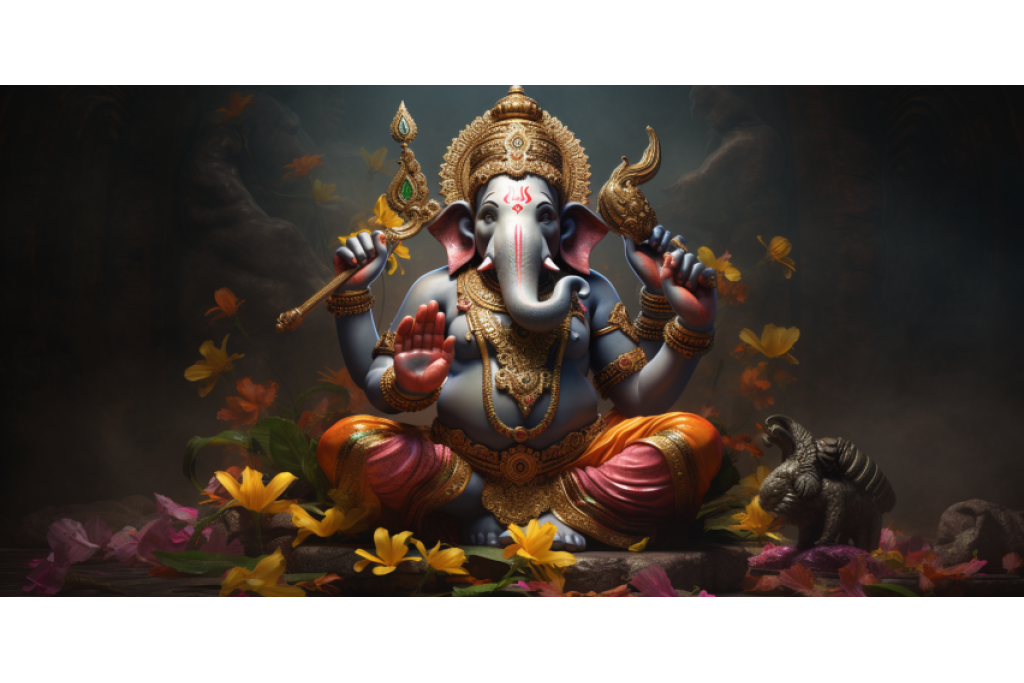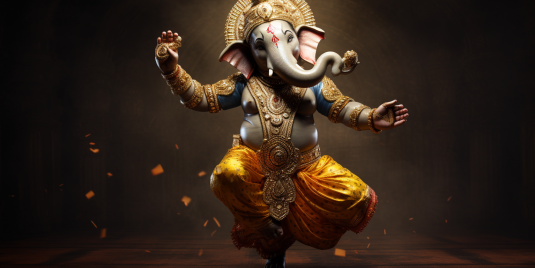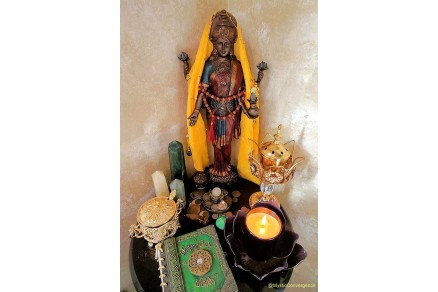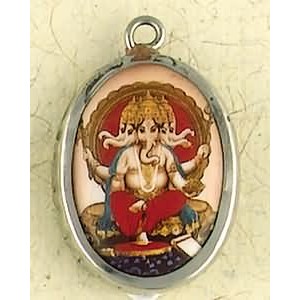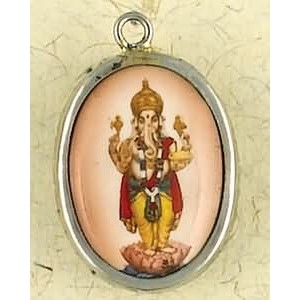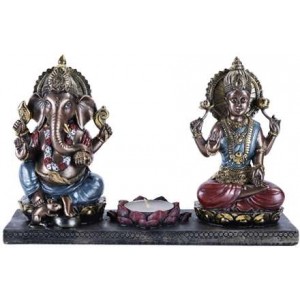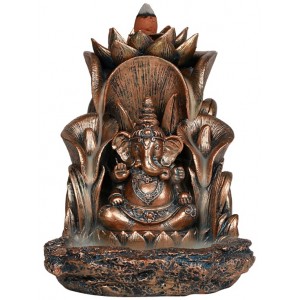Exploring the Mythology and Teachings of Ganesha
- August 08, 2023
- 584
- 0
Ganesha, the elephant-headed deity revered in Hinduism, stands as a symbol of wisdom, success, and new beginnings. Known as the Lord of Success and the Remover of Obstacles, he is one of the most recognizable and widely worshipped gods in the Hindu pantheon. With his unique appearance, featuring an elephant head, a pot belly, and a humble mouse as his vehicle, Ganesha's image is rich with symbolism and meaning. His teachings and worship transcend regional and cultural boundaries, making him a universal figure who continues to inspire and guide people across generations. Whether it's through mythology, rituals, or artistic expressions, Ganesha's presence resonates with seekers, scholars, and devotees alike. Let's explore more about this fascinating Hindu God, Lord Ganesh or Ganesha.
The Birth of Ganesha
Ganesha's birth is a tale filled with intrigue and divine intervention. Born to Shiva and Parvati, Ganesha's creation was a result of Parvati's longing for motherhood. However, his birth was no ordinary event. In one version of the story, Shiva decapitated the young boy in a fit of rage, only to replace the head with that of an elephant. In another version, the Sun-God, Lord Shani, severed the child's head with his powerful gaze, leading to the elephant replacement. These tales symbolize Ganesha's unique connection to wisdom and intellect.
Is it Ganesh or Ganesha?
Both spellings, Ganesh and Ganesha, are correct, but there are some differences in meaning between the two. Ganesh is the more commonly used spelling in Northern India, while Ganesha is the preferred spelling in Southern India.
In terms of meaning, Ganesh means “lord of the multitudes” or “lord of the people,” while Ganesha means “lord of the ganas” or “lord of the categories.” The term “ganas” refers to a group of beings that are associated with Lord Shiva, one of the principal deities of Hinduism and the father of Ganesha.
How Ganesha Got His Elephant Head
One of the most well-known myths about Ganesha is how he acquired his elephant head. According to legend, Parvati created a boy out of dirt to guard her home. When Shiva returned and was denied access, he severed the boy's head in anger. Realizing his mistake, he sent his warriors to find a replacement head, and they returned with that of an elephant. Shiva attached it to the boy's body, revived him, and made him the leader of his troops. This myth highlights Ganesha's transformation and his rise to prominence as a revered deity.
Ganesha and the Moon
Another fascinating myth involves Ganesha and the moon. Known for his love of sweet treats, Ganesha once overindulged at a feast and stumbled while carrying leftovers. The moon, Chandra Deva, laughed at his fall, leading Ganesha to curse him to disappear from the sky. Though he later lessened the curse, the moon's appearance was forever altered. This playful story illustrates Ganesha's human-like qualities and his ability to influence the cosmos.
What Does Ganesha Symbolize?
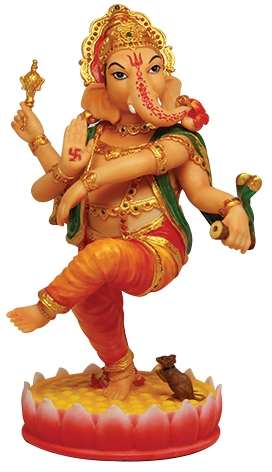 Ganesha symbolizes a number of things. Here's a breakdown of the main symbols:
Ganesha symbolizes a number of things. Here's a breakdown of the main symbols:
- Elephant Head: Symbolizes intelligence and discriminative power. It represents wisdom and the ability to differentiate between right and wrong.
- Broken Tusk: Illustrates his ability to overcome dualism and signifies his sacrifice for the greater good.
- Oversized Ears: Signify wisdom and his ability to listen to those who seek help. They serve as a reminder of the importance of listening and understanding.
- Curved Trunk: Represents intellectual potential and flexibility. It's a symbol of adaptability and the ability to navigate through challenges.
- Pot Belly: Holds infinite universes and signifies nature and equanimity. It symbolizes Ganesha's capacity to consume the sorrows of the world.
- Four Arms: Represent the inner attributes of the body, including the mind, intellect, ego, and conscience. They symbolize the complexity of human nature.
- Mouse Ride: Reflects his humbleness and ability to access all areas of the mind. It's a symbol of Ganesha's mastery over desires and thoughts.
- Axe and Prasad: The axe reminds followers to cut ties with materialistic attachments, while the Prasad near his feet symbolizes sharing and giving.
These symbols collectively paint a picture of a deity who embodies wisdom, humility, adaptability, and compassion. Ganesha's form is a philosophical guide, offering insights into human nature, spirituality, and the pursuit of enlightenment.
Worship of Ganesha: A Journey Across Time and Cultures
Hindu Origins
Ganesha's worship has deep roots in Hinduism, where he is revered as the Lord of Success and the Remover of Obstacles. As the first-born son of Shiva and Parvati, Ganesha's veneration began in ancient India. He is celebrated as the god of intellect, wisdom, and new beginnings. His worship is nonsectarian, and followers, known as Ganapatyas, can be found in all sects of the faith.
Spread to Other Regions
Ganesha's appeal transcends the boundaries of India, and his worship has spread to other parts of Southeast Asia, including Indonesia, Thailand, and Cambodia. His image has been found in archaeological sites across these regions, reflecting his universal appeal. Ganesha's symbolism and teachings have resonated with various cultures, leading to his integration into different religious practices.
In contemporary times, Ganesha's role as the Remover of Obstacles has taken on new significance. He is invoked at the beginning of any venture, whether it's starting a business, buying a home, or embarking on a personal journey. His image is often placed at entrances to ward off evil and ensure success. A statue of Ganesha is a popular housewarming present in many cultures, including among modern pagans.
Devotees of Ganesha celebrate him in many ways, including:
- Ganesh Chaturthi: This 10-day festival celebrates Ganesha's birth and is marked by grand processions, artistic creations, and community gatherings. It's a time of joy, devotion, and reflection on Ganesha's teachings.
- Daily Rituals: Many followers begin their day with prayers to Ganesha, seeking his blessings for a successful and obstacle-free day.
- Art and Culture: Ganesha's influence extends to art, music, and dance, where his form and stories continue to inspire creativity and expression.
Why do People Pray to Ganesh?
People pray to Ganesh to ask for assistance in removing the obstacles in their paths and clearing the way to success, especially in business and finances. He is also often prayed to for help with environmental issues such as wild fires, floods and drought.
What is the Moral of Ganesh?
The moral of Ganesha gives us a rich mythology. The teachings of Ganesha are profound and multifaceted, reflecting his role as a deity of wisdom, success, and new beginnings. Here's an exploration of the major teachings attributed to Ganesha:
- Wisdom and Intellect: Ganesha's elephant head symbolizes wisdom and intellect. He teaches the importance of using discernment and understanding in all aspects of life. His teachings emphasize the pursuit of knowledge and the application of intelligence in decision-making.
- Overcoming Obstacles: Known as the Remover of Obstacles, Ganesha's teachings focus on resilience, adaptability, and problem-solving. He encourages followers to face challenges with courage and creativity, finding innovative solutions and learning from difficulties.
- Humility and Compassion: Ganesha's ride on a humble mouse symbolizes his humility and compassion. He teaches the importance of treating all beings with respect and kindness, regardless of their status or appearance. His compassionate nature is a reminder to approach others with empathy and understanding.
- Balance and Moderation: Ganesha's large belly represents the ability to digest all experiences, good or bad. He teaches the importance of balance and moderation in all aspects of life, whether it's emotions, desires, or material possessions. His broken tusk symbolizes the sacrifice of ego and the pursuit of a balanced life.
- New Beginnings and Success: As the god of new beginnings, Ganesha's teachings inspire optimism, ambition, and the pursuit of success. He encourages followers to embrace new opportunities with enthusiasm and determination, seeking growth and fulfillment.
- Devotion and Spiritual Growth: Ganesha's devotion to his mother, Parvati, and his role as a spiritual guide reflect his teachings on spiritual growth and inner development. He encourages followers to cultivate inner wisdom, self-awareness, and a deep connection to the divine.
- Art and Creativity: Ganesha's influence on art, music, and dance highlights his teachings on creativity and self-expression. He inspires followers to explore their creative potential and express themselves authentically, enriching their lives and the lives of others.
- Universal Brotherhood: Ganesha's nonsectarian worship and universal appeal teach the importance of inclusiveness and acceptance. He embodies the idea of universal brotherhood, transcending cultural, regional, and religious boundaries.
- Environmental Consciousness: Some interpretations of Ganesha's form and myths also highlight teachings related to environmental consciousness and harmony with nature. His connection to the natural world serves as a reminder to live in harmony with the environment.
Ganesha's teachings offer a rich and comprehensive guide to living a life of wisdom, compassion, success, and fulfillment. His symbolism and myths provide valuable insights that resonate across cultures and generations.
Suggested Rituals to Ganesha: Connecting with the Divine
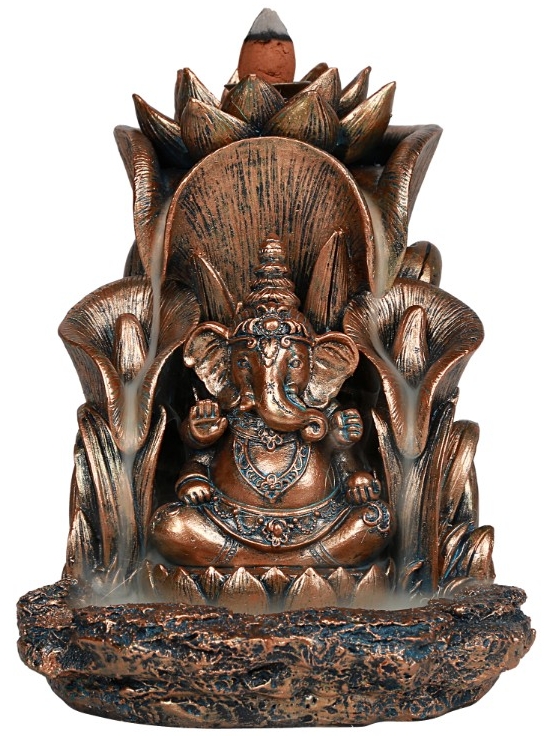 Ganesha's worship is filled with rituals that are both symbolic and practical. Whether you're seeking success, wisdom, or spiritual growth, these suggested rituals can help you connect with Ganesha's energy and teachings:
Ganesha's worship is filled with rituals that are both symbolic and practical. Whether you're seeking success, wisdom, or spiritual growth, these suggested rituals can help you connect with Ganesha's energy and teachings:
- Daily Invocation: Begin your day with a simple invocation to Ganesha, seeking his blessings for a successful and obstacle-free day. Light a lamp or incense and offer a short prayer or mantra, such as "Om Gan Ganapataye Namah."
- Offering Sweets: Ganesha is known for his love of sweets, especially modak. You can offer sweets as prasad (a devotional offering) during prayers or meditation. This ritual symbolizes sharing and gratitude.
- Creating a Ganesha Altar: Designate a space in your home for a Ganesha altar. Place an image or statue of Ganesha, along with offerings like flowers, fruits, and water. Spend a few moments in daily meditation or reflection at this altar.
- Participating in Ganesh Chaturthi: If possible, participate in the Ganesh Chaturthi festival, celebrating Ganesha's birth. You can create or buy a Ganesha statue, perform a puja (worship ceremony), and immerse the idol in water as per tradition.
- Practicing Mindfulness and Compassion: Embrace Ganesha's teachings of wisdom and compassion by practicing mindfulness and kindness in daily life. Engage in acts of charity, volunteer work, or simply being present and compassionate with those around you.
- Artistic Expression: Explore your creativity by engaging in artistic activities inspired by Ganesha. Paint, draw, dance, or write, expressing your connection to his energy and teachings.
- Environmental Stewardship: Honor Ganesha's connection to nature by engaging in environmentally conscious practices. Plant a tree, reduce waste, or support eco-friendly products and initiatives.
- Business and Career Success Rituals: If you're embarking on a new business venture or career path, perform a simple ritual to Ganesha, seeking his guidance and blessings for success. This can include lighting a lamp, offering fresh flowers, and reciting specific prayers or mantras.
May Ganesha's teachings continue to inspire and guide, fostering a path of wisdom, compassion, and success for all.
Related Posts
Creating a Prosperity Altar
- 1709
- 0
Setting up a prosperity altar can be a great way to attract abundance into your life and to be grateful for all you have.
Hecate Unveiled: Exploring the History and Mythology of the Witchcraft Goddess
- 803
- 0
Step into the twilight whispers of ancient myths with the Goddess Hecate, the enigmatic ruler of crossroads, magic, and the moonlit night. She's a figure shrouded in mystery, her torches casting shado..
Related Products
Ganesha CD
$18.95



